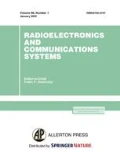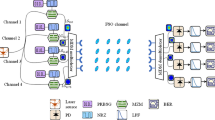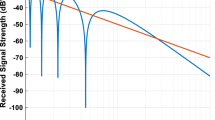Abstract
The development of anti-interference radar stations is impossible without the knowledge of interference parameters. The main difficulty of designing of anti-interference airborne radar stations for air surveillance is associated with the suppression of reflections from the underlying surface. In order to estimate the azimuthal-velocity parameters of reflections from the underlying surface in airborne surveillance stations with unambiguous distance measurement we implemented the simulation model of digital output signals of a coherent radar receiver. During the model development we used digital maps and an antenna with low side lobe level. With the help of simulations we have justified the necessity and possibility of development of anti-interference airborne radar stations with low-channel design and simultaneous application of direct inter-period and inter-channel correlation connections.
Similar content being viewed by others
References
V. S. Verba, Aircraft Systems of Radar Surveillance and Guidance. State and Development Trends (Radiotekhnika, Moscow, 2008) [in Russian].
D. K. Barton, “Land clutter models for radar design and analysis,” Proc. IEEE 73, No. 2, 198 (Feb. 1985), DOI: 10.1109/PROC.1985.13133.
V. G. Gartovanov, M. R. Araslanov, V. D. Batyev, O. Ye. Tishchenko, “Multichannel self-compensation angular-velocity system of surveillance radar protection against combined masking interferences,” Telecom. Radio Eng. 69, No. 12, 1087 (2010), DOI: 10.1615/TelecomRadEng.v69.i12.50.
V. G. Gartovanov, V. D. Batyev, M. R. Araslanov, Yu. P. Kudriavtsev, “Estimation of potential noise immunity of an airborne surveillance radar with the univocal measuring of distance from combined masking noises,” Prikladnaya Radioelektronika 3 (3), 316 (2012).
Ya. D. Shirman (ed.), Radioelectronic Systems. Design Fundamentals and Theory (Radiotekhnika, Moscow, 2007) [in Russian].
G. P. Kulemin, “Radar interferences from the sea and terrain for radar stations of centimeter and millimeter ranges,” Proc. of Int. Sci. and Tech. Conf. on Modern Radiolocation (Kyiv, 1994), pp. 23–29.
Author information
Authors and Affiliations
Corresponding author
Additional information
Original Russian Text © V.G. Gartovanov, V.D. Batyev, 2016, published in Izv. Vyssh. Uchebn. Zaved., Radioelektron., 2016, Vol. 59, No. 6, pp. 30–37.
About this article
Cite this article
Gartovanov, V.G., Batyev, V.D. Necessity and possibility of taking into account of space and time domain parameters of interfering reflections from the underlying surface in the design of anti-interference airborne radar stations for air surveillance. Radioelectron.Commun.Syst. 59, 256–261 (2016). https://doi.org/10.3103/S0735272716060042
Received:
Published:
Issue Date:
DOI: https://doi.org/10.3103/S0735272716060042




